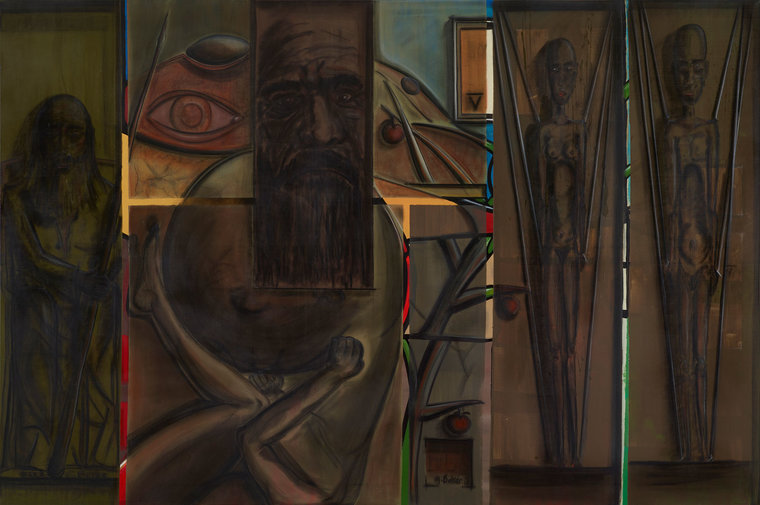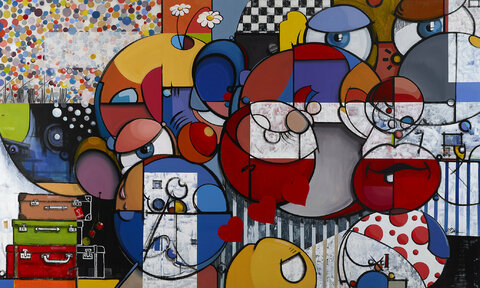Ghazi Baker’s The Creation of Evil, 2015, is a painting of two layers. The underlayer is painted with bright primary hues of red, yellow, blue, and green, and the top layer depicts eerie figures executed with a far more muted palette of burnt umber and charcoal. The contrast is heightened along the vertical and horizontal bar-like stripes separating the two layers, through which the viewer gets a glimpse of what is underneath.
On the right, the painting shows figures of a naked man and woman, seemingly Adam and Eve, encased and confined within two vertical panels. To their left, we see a disjointed apple tree, refracted across several surrounding panels. In the painting’s central left part, we notice a human figure in a fetal position – a fetus holding his giant, swollen, circular head. The bulbous fetus head is confined within an overlapping panel, which shows the face of an austere bearded man, next to whom is an all-seeing eye, perpetually open and watching. The last panel at the far left of the painting’s horizontal composition shows a seated, wizened old man holding a spear.
The concept of the creation of evil and its connection to the ‘Tree of Knowledge’ is primarily rooted in Judeo- Christian beliefs, particularly the story of Adam and Eve. In the biblical narrative, when God created the Tree of Knowledge of Good and Evil, He instructed Adam and Eve to not eat its fruit. They disobeyed him, and as a consequence of this ‘original sin,’ they became aware of good and evil. The fetus with the bulbous head represents the acquisition of knowledge and, with it, the burden of free will, choice, and all the moral responsibility that humanity must contend with due to Adam and Eve’s disobedience.
The face of the man with the beard is placed above and on top of the rest of the panels behind it: this is the face of a man of a religious figure, symbolic of the prophet Moses, who is revered as the greatest prophet and teacher the Judaic tradition and is considered the founder of the monotheistic belief, claimed by the religions of Judaism, Christianity, Islam and Bahai. The artist depicts the prophet Moses staring at the viewer in judgment and condemnation.
The narrowness of the panel around his face intensifies the sense of his inflexibility, while the figures in the back have no choice but to submit themselves to this oppressiveness. Creation of Evil could be understood as a critique of the dominant Judeo-Christian religious narratives and how they shackle humanity, just as they have shackled Adam and Eve.
The under-painting, with its vibrant and vivid colors, is
hidden behind the morose and overbearing gloom of the
surface panels. The nature of these panels, their clear
separation and positioning, reflects their intentionally
constructed nature, while the superimposing first layer
suggests its authenticity and congruence with reality. The
painting is an invitation to question which perception of
human nature is genuine, which feels more natural, and
finally, to what extent do we allow religious narratives to
control us?
signed in English front lower left/titled in English on reverse






